Excerpts from Jim Conrad's
Naturalist Newsletter
entry dated September 22, 2022, issued from near Tequisquiapan, elevation about 1,900m (6200 ft), N20.565°, W99.890°, Querétaro state, MÉXICO
CREEPING ZINNIA
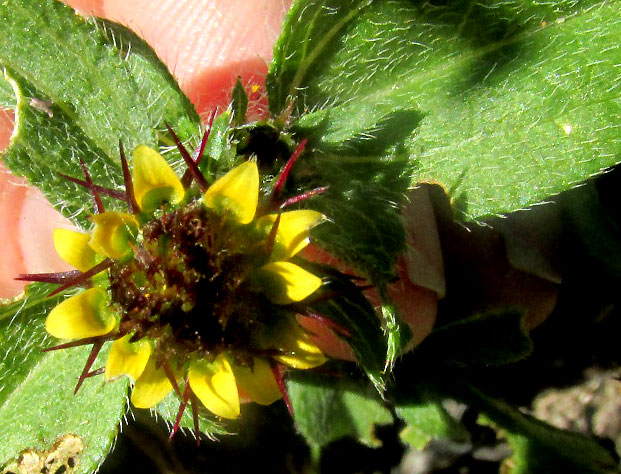
A large field lay fallow, probably because the rainy season this year came too late and too little. Still, the field was resplendent with windblown green grass and millions of yellow-flowered Cabezonas, either weeds or wildflowers, depending on your perspective. Admiring a particularly pretty trail-side community of yellow Cabezona, purple Prairie Verbena and white Arugula/Roquette amid dark green grass, weakly leaning on other vegetation on shadowy ground below a canopy of Cabezona flowers, a little herb bore several thumbnail-size flowering heads with the curiously spiky features shown above. Here's what the plant looked like, nudged into a sunny spot:
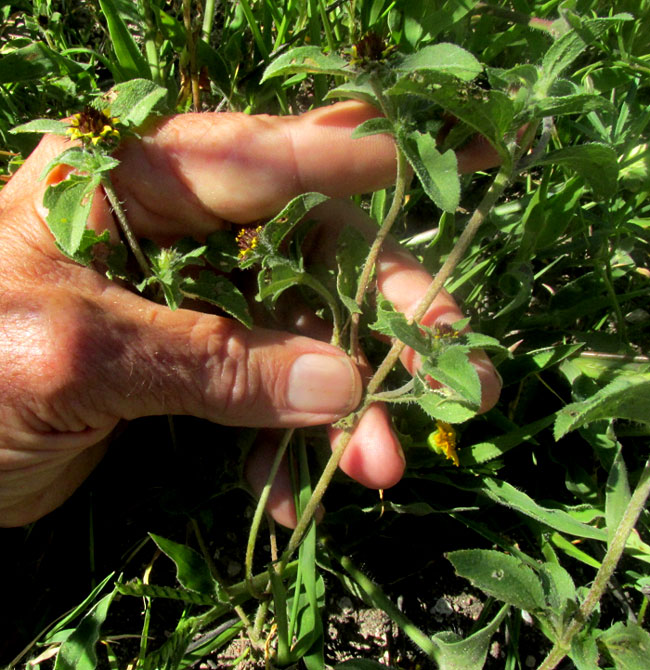
With the flowering heads composed of dark purple disc florets packed into the blossom's center, and a dozen yellow, petal-like ray florets along the periphery, our plant clearly was a member of the vast Composite or Aster Family. Besides the very small flowering head, or capitula -- only about 1cm across -- proportionally, the ray florets were uncommonly short and triangular shaped. Numerous Aster Family genera produce spines in their flowering heads, but on such un-thistle-like plants as this, spines among the capitula were remarkable. Here's a side view better showing the disc florets and the spines' disposition:
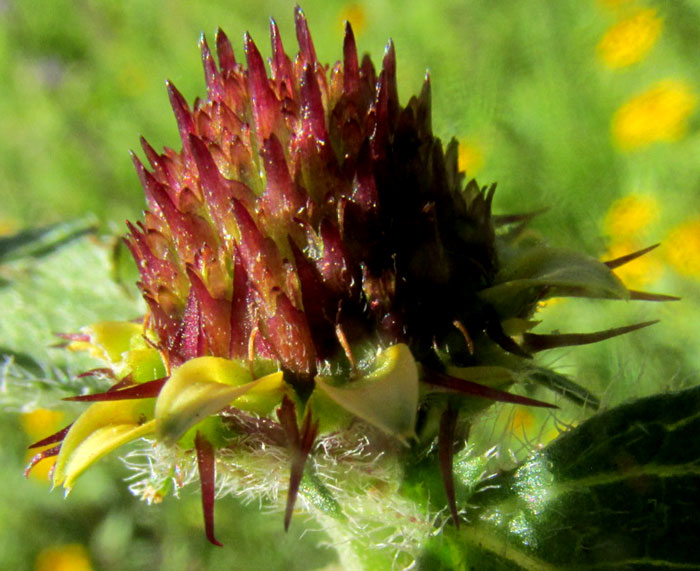
The purple mound of disc florets is spiky with hard, sharp tips of scale-like paleae, each palea rising above and partly wrapping around the single disc floret below it. Many members of the Aster Family produce no paleae, and when they do, normally they remain hidden below the disc floret corollas, so these tall, stiff paleae are distinctive, and good field marks for identification. In the above picture, notice the disc florets' cylindrical, purple, five-toothed corrolas beside their attending palea. Also, the yellow ray florets below the disc florets are somewhat scoop-shaped, showing no trace of pollen-producing stamens, but with long, slender, tan-colored styles curving upward.
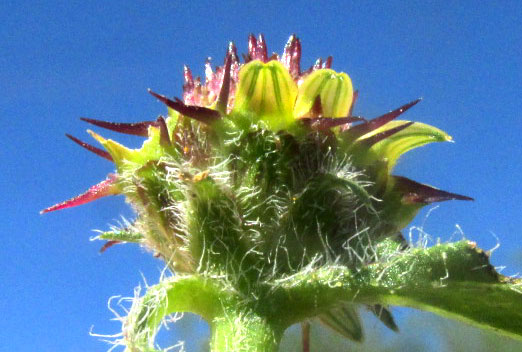
Below the capitulum, the green, cup-like involucre consists of maybe ten, rounded-tipped, overlapping, long-hairy bracts, or phyllaries. Also in the above picture you can see that the capitulum bears no stem between itself and the leaves below it. Moreover, it's clear that the stiff, purple spines don't arise from the phyllaries, as they do with thistles, but rather from the flowering part of the head. When a head is broken open, it's clear where they arise:
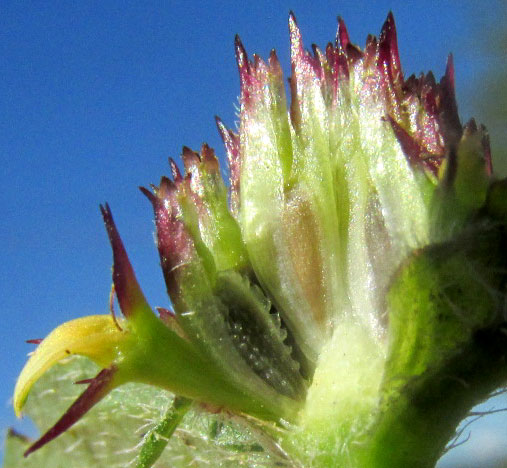
In the above broken open capitulum, at the bottom left corner, a ray flower's short, yellow ray arises from atop the caryopsis-type fruit, and the caryopsis' top bears three purple spines. The spines are interpreted as one of the rainbow of different forms Aster-Family pappuses can assume. The mostly commonly seen form in other Aster-Family genera consists of white, slender or feathery hairs which on the mature fruit will serve as parachutes for wind dispersal, as with dandelions. In Spanish needle species, the pappus consists of slender, barbed spines that stick to animal fur. Maybe our plant's spines serve both for dissemination and to dissuade herbivores from eating the flowers.
In the above picture we can also see that the caryopsis forming on the disc floret immediately above the ray floret is of a different form and color, bears no spines, and along the caryopsis' side grow low toothlike projections, or tubercles. Such great difference in caryopsis features in one capitulum is unusual. Also in the above picture, we can better see how each disc floret's purple-tipped paleae partially wrap around the floret it stands next to. Crumbling up an almost-mature capitulum produces the following interesting debris:

In the picture's left we see two ray floret caryopses, each armed with three purple spines. In the image's top, right corner, a spineless disc floret has a smaller caryopsis of a different shape. In the photo's center some disc floret's appear to produce no caryopsis at all.
Ten years ago in Morelos state south across the mountains from Mexico City, I met the very similar Creeping Zinnia, Sanvitalia procumbens. Now we're dealing with a different species in the same genus.
Fortunately, Andrew M. Torres's 1964 "Revision of Sanvitalia (Compositae-Heliantheae)" is freely available online, and in that publication our plant works out to SANVITALIA OCYMOIDES, also sometimes called Creeping Zinnia, though that name appears to apply to all five or so of the species in the genus, all species endemic to the Americas.
I'm hesitant to use the name Sanvitalia ocymoides because the authoritative Flora del Bajío in its 2011 treatment of the genus says that we don't have that species in Querétaro, but rather plants looking like ours are Sanvitalia angustifolia. The Flora further says that various authors cite Sanvitalia ocymoides in Querétaro, and it's admitted that various collections display features approaching that species, but in general terms, the Flora says, they're much more similar to S. angustifolia. However, it's not stated what those general terms are, while in the revision by Torres specific features are mentioned making our plant S. ocymoides. The latter species' leaves are broader, like ours, the leaves are hairier, like ours, and the plants tend to recline on the ground, like ours. Both authors suggest hybridization between the species, but our photographed plant fits Torres's descriptions for Sanvitalia ocymoides
On the grounds that the Flora del Bajío authors don't state specific reasons for rejecting Torres's opinion, I'm sticking with Sanvitalia ocymoides. Both names are accepted internationally as legitimate, though I suspect that genetic studies will cause the two species to be lumped, with Sanvitalia ocymoides being the first-published name, and therefore taking precedence.
Sanvitalia ocymoides occurs from extreme southern Texas south to here in Querétaro, at elevations from 300-2250m (900-7500 feet). It likes disturbed and compact, clay soils in semiarid regions.
I find no information about this little plant beyond descriptions of its anatomy and conditions of its presence. It's one of those plants without its own solid name, generally overlooked and ignored, just doing its modest job of pumping out oxygen, holding soil in place, and ultimately yielding up its body to any herbivore who might be hungry, and then bestowing organic matter to the soil.